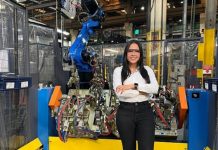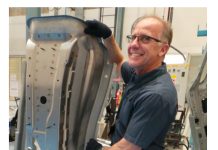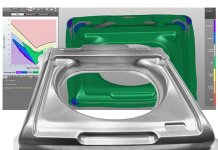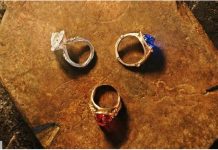To face the metal forming challenges of the future we need to employ methods to engineer processes wherein we evaluate decisions across a broader range of decision drivers. In the pas for example, many of us may have been required to reduce the number of cams used to produce our parts; in the hope of more cost effective tooling and parts. Similarly, we often engineer for the smallest blank aiming for reduced piece cost. These types of process “standards” or “norms” are common in the industry and applied expecting to reduce costs.

A sheet metal component with a “backdraft” flange
As method planners validating stamping processes or tooling engineers following die into tryout and production, many of us have seen first-hand that these “savings” come with a cost. Product concessions must be made, or quality compromised in the final assembly; how much is really saved by eliminating a cam or by reducing the blank size? And was that savings looked at in an objective comparison for the “opportunity cost” of a disrupted product design or delayed launch?
We must be able to predict that our proposed process plan savings offset any additional production costs; which could result from reduced process safety, altered part quality, production robustness or dimensional accuracy.

Two possible processes for producing an automotive B-pillar stamping
One choice for the stamping process is to minimize the number of cam operations to reduce tooling cost/complexity. A very common goal communicated by many die process engineers and method planners as a means of limiting tooling cost.
An alternative stamping process choice is to develop the surface of the flange on the punch, and trim using cams. Cam trimming the flange could potentially improve the dimensional integrity of the flange in two ways; first by assuring that the developed trim line is consistently positioned relative to the remainder of the part, something that trimming on the binder cannot assure; secondly, by performing the trimming in a position that is closer to final with fewer subsequent operations.

Many potentially offsetting gains and losses are possible with the two processes
Without objective data each seems viable and can be argued as an optimum process—subjectively. In fact, many in industry would eliminate one of these variants without engineering or simulation, as the decision is obvious to them. However, if one were to model each process and evaluate across multiple decision drivers one might find that there may be offsetting benefits, as well as costs, for each process. Without quantitatively evaluating both processes one could never truly say which process is better than the other.
20 years ago when AutoForm first arrived on the market, merely completing a draw analysis with reliable split predictions and reasonable wrinkling predictions was enough. Draw simulations back then allowed the modelling different bead restraint or binder pressure to find draw concepts that could pass; those innovations allowed industry to limit the need for proof tools to know that a formable part was indeed possible. 10 years ago the use of simulation to predict potential springback in advance high strength materials, of not only the draw but also the trimmed and flanged part allowed for better simulate the effects of the complete process. Often indicating what needs to adjust in the proposed method to improve. Often compromising on the product geometry, or adding material and tooling cost in the meantime.
Today, more powerful computers are able to solve the simulations that once took all day in a matter of hours and minute. A passing result can be found faster than ever before. But is finding a passing version of the first tooling concept faster really the path to further savings, or are opportunities being missed limiting metalforming analysis work to the tooling process that one subjectively assumed was cheaper, easier, or higher quality? Maybe the process that one rejected as unreasonable, based on rule-of-thumb guidance, might pass with higher repeatability, or better throughput in production. Can one prove it?
We believe that the future savings in the metalforming industry come not from faster, better springback predictions alone or more automated development of tooling surfaces only; but that the next significant improvements will arrive when those improvements are part of a broader more comprehensive modelling and evaluation of digital process plans. That the path to optimum products is to identify a proposed stamping processes Quality, Cost, and Lead Time capabilities, and choose those processes that help us achieve our goals without offsetting losses elsewhere.














Processing the job – and having press constraints available – was a natural step forward to running the simulation. I think many folks think simulation is a check box item focused on drawing or stretch forming. You at least now have the ability or framework to simulate – or model – flanging, trimming, restrike and get meaningful data beyond the garden variety FEA results. You are providing practical results – like force and energy. I see the process planning functionality as a real game changer and AutoForm is the prime owner
I totally agree! Practical results is AutoForm’s strength. I do not see anybody else here really being able to compete at the moment.